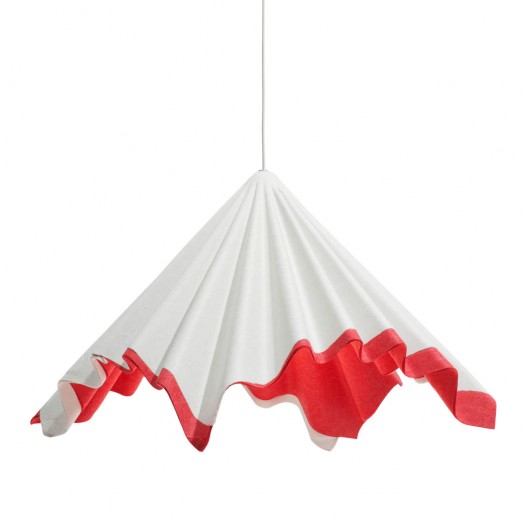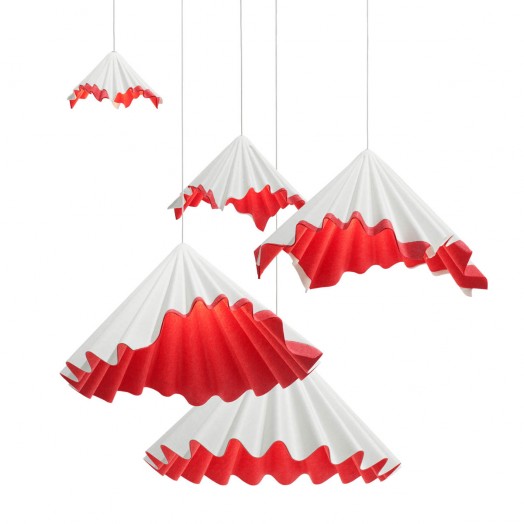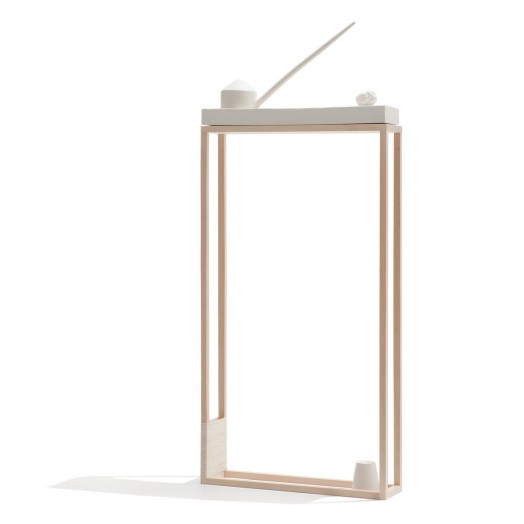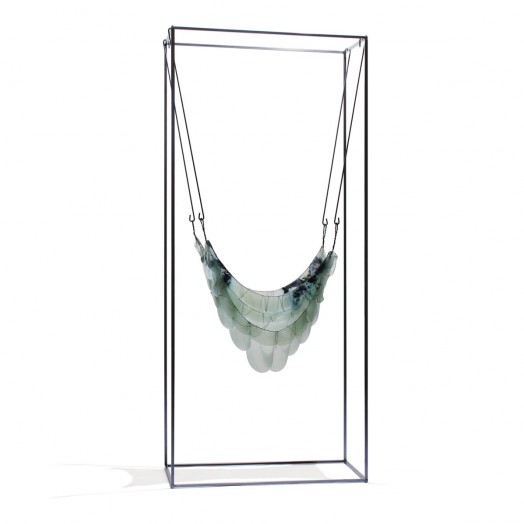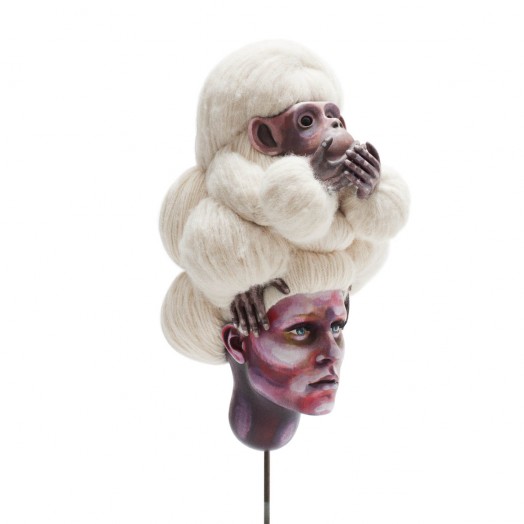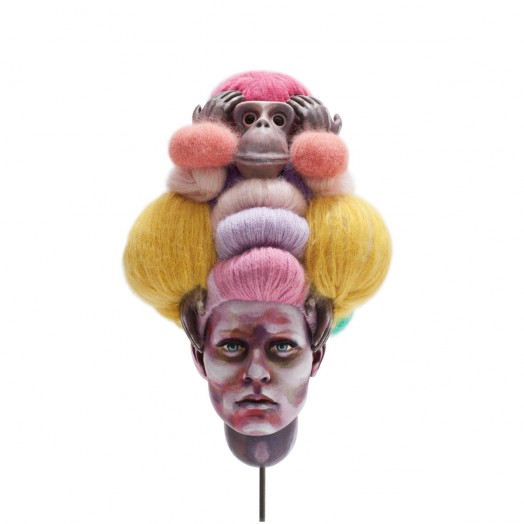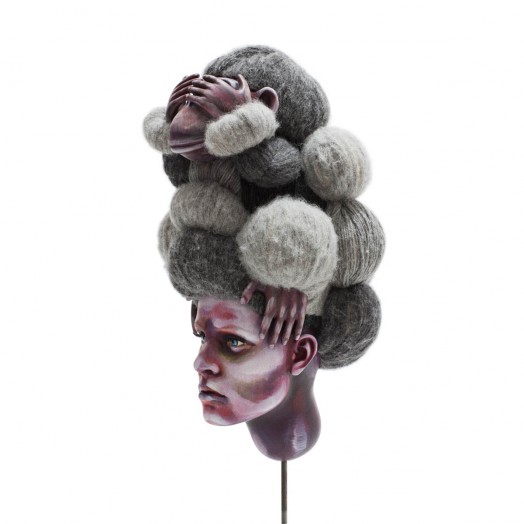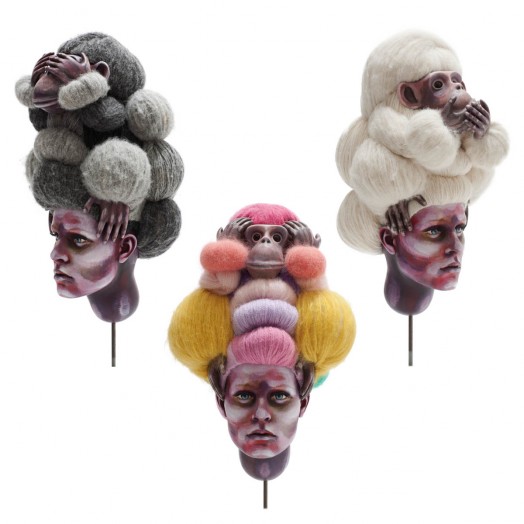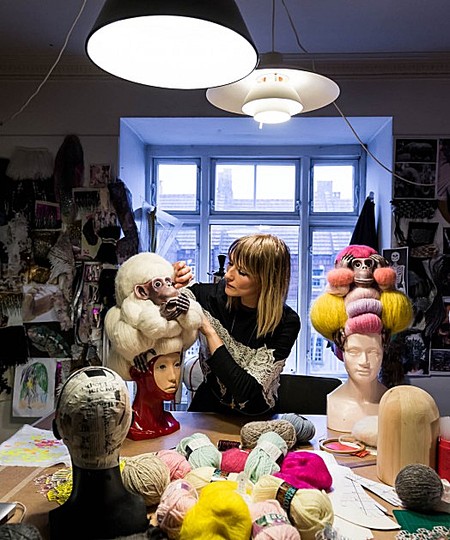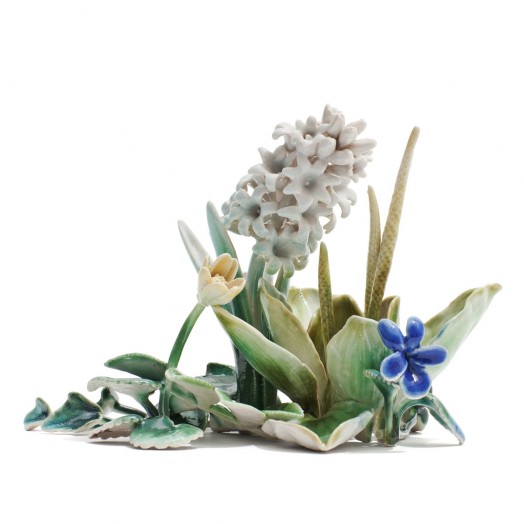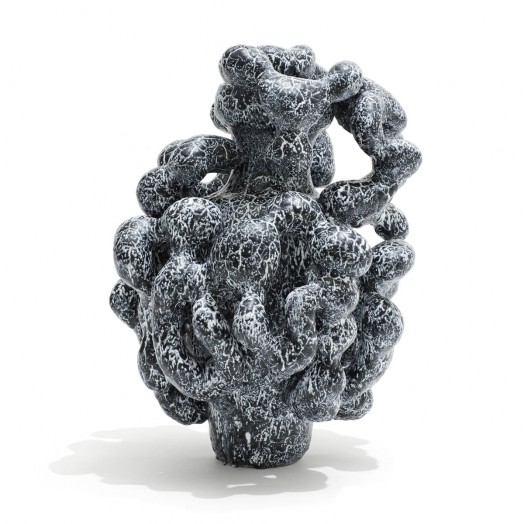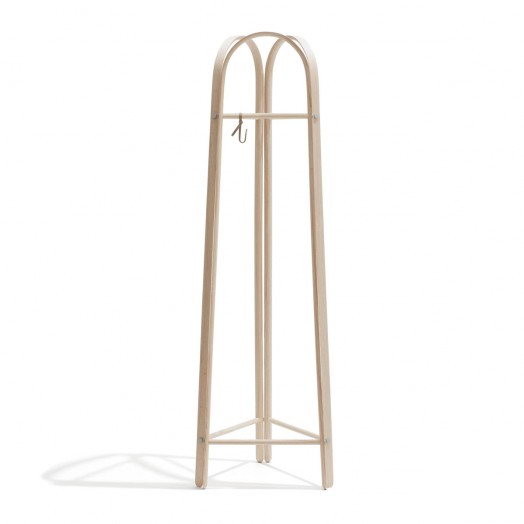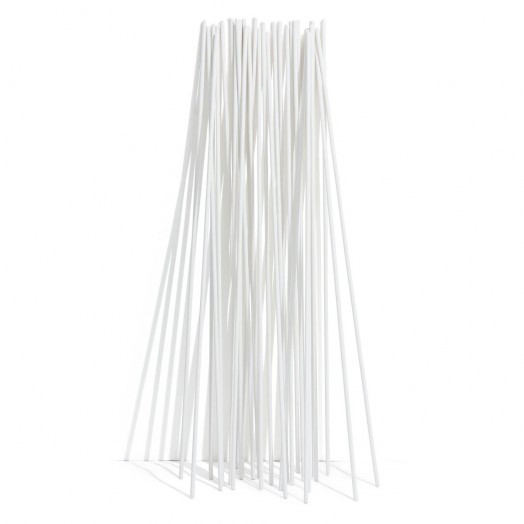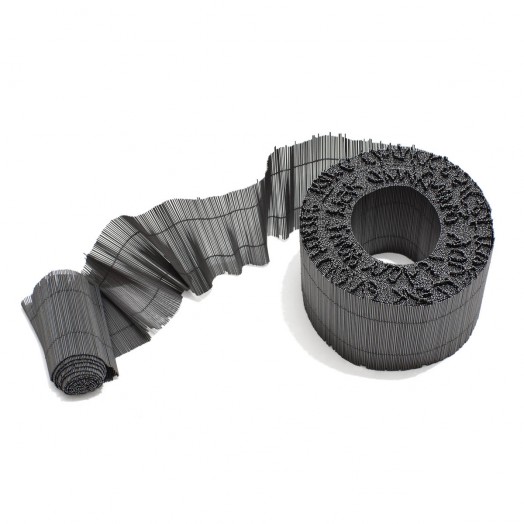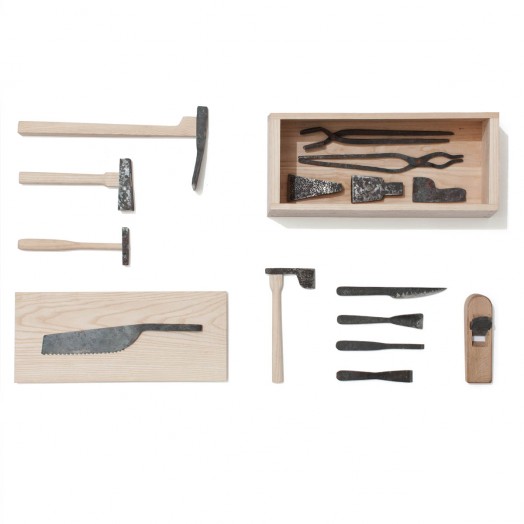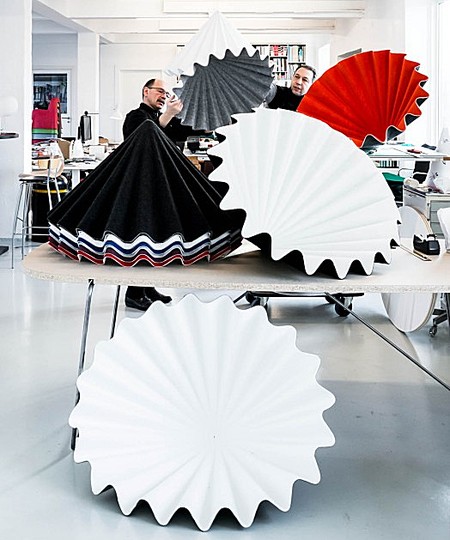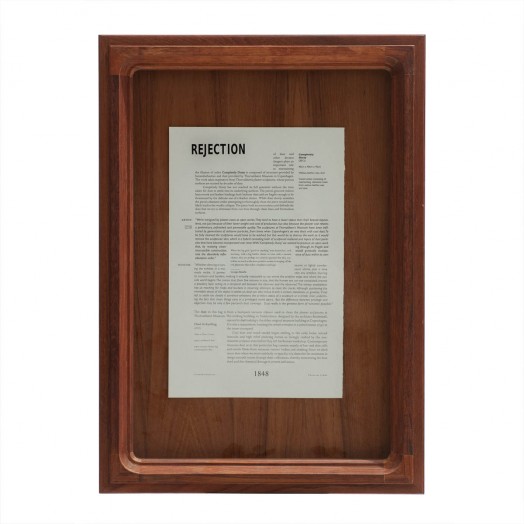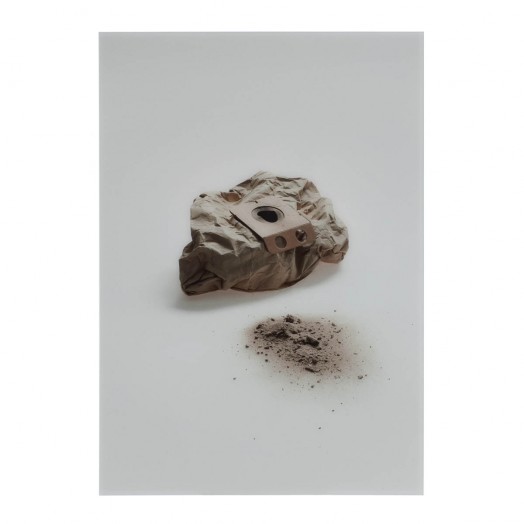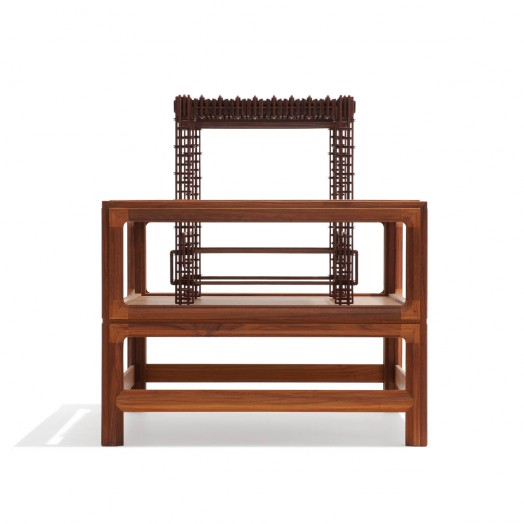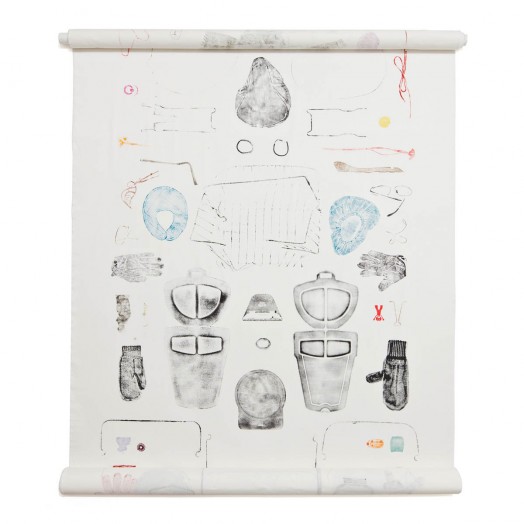Mindcraft 14 Milano
Exhibition: April 8-13, 2014
Address: Via Ventura 6, 20134 Milano
Untitled#3
The work consists of two ceramic objects displayed on a clay podium. The composition is displayed on a hand-built ‘furniture suite’ made in wood. The piece as a whole is a non-functional sculpture where the individual forms interact to create a coherent whole while simultaneously challenging each other. The forms are inspired by familiar everyday objects, which acquire new dynamics and energy when combined.
Suspension I
The strategy revolves around the art of the possible; the process is one of crossing boundaries and bringing worlds together in order to gain new ground.
Suspension I is a trial version of a larger format than before. The size and the glass as material is stretched to its limits.
In a unique approach, Pipaluk Lake creates a system of metal wires to tie large sheets of glass together. The many thin wires form a mesh that is strong enough to be suspended in the kiln. The glass moves through the holes of the mesh as gravity pulls on the heated material. The metal wires create relations on several levels: between metal and glass and between cold and heat. Physically, the wire also represents the impact of mind in combination with craft, a connection between the conceptual and the sensory realm.
After the firing, the wire that framed the form-giving process now appears as an integral part of the expression of the finished object.
The Dance of the Deaf and Dumb Eye.
With inspiration from the classic Japanese monkeys, which have been interpreted in the West as a naive attempt to shut out the outside world by refusing to see, hear or speak, these clothing sculptures contain visual references to the French court under Louis XVI, during whose reign excessive abundance and poor communication between nobility and citizenry led to the French Revolution. With this in mind, the monkey trinity is drawn into a contemporary rococo, where globalization is skewed by imbalanced capitalism, dangerous balances of power and a stubborn struggle between religion and freedom of speech. The monkeys become narrative symbols of today’s blind consumers and the historical Marie Antoinette.
Flower Arrangement consists of modelled plants made in glazed stoneware and combined in an artificial arrangement.
In Flower Arrangement, Marianne Nielsen interprets a traditional source of inspiration, as flowers are a classic motif in the craft tradition. The emotional significance we attribute to flowers makes them particularly interesting for Marianne Nielsen to explore.
The imitation of plants incorporates the contrast between nature and culture; the portrayed and the portraying. The works are more about manmade artefacts than about nature; the natural motif is used to highlight the material and the ceramic tradition.
Horror Vacui – the fear of empty space – is a collection of ceramic works that embraces ceramics history and reinterprets classic virtues in the ceramics tradition. The works in the collection are all archetypal jar shapes, excessively encircled by wildly unruly three-dimensional ornaments. The works may be viewed as a sheer beauty and a tribute to the many faces of glaze and clay, which, in its fired form, inscribes itself in eternity.
Elements is a dress rail constructed of multiple identical elements. The user can alter the size by increasing or reducing the number of elements, thus shrinking or expanding Elements to match the current need.
Elements is made of steam-bent ash wood. The wood is steam-heated, which makes it elastic and pliable. When it dries, it keeps the new shape. The inspiration came from various steam-bent products, including wooden snow shoes, a Greenlandic kayak and the wooden handle on a teapot. Line Depping has used steam-bent components in several of her projects and is fascinated with pliability of the wood when it is exposed to steam. Line Depping has also worked with other techniques to bent wood. In 2012 she used precompressed ash wood to make Hook, a coat hook that she designed for MINDCRAFT12, and which was subsequently put into production by the design manufacturer WRONG FOR HAY.
Kristine Tillge Lund’s MINDCRAFT project is a site-specific, material-based study.
Porcelain is commonly perceived as a precious material. The utilitarian porcelain objects that we use on a daily basis are often expensive and fragile; they are objects that we handle with care. This fragility, which is one of the most prominent and familiar qualities of porcelain, invites a particular behaviour in our day-to-day interactions with the material.
Fragility is also the key quality and the point of departure for this piece, which consists of 600 porcelain rods leaning against two opposite walls. The installation presents a fragile material in a precarious set-up. The rods are as tall as an average adult.
Every year, the exhibition attracts thousands of visitors, which makes it a perfect place to carry out an experiment aimed at tracking how the visitors’ behaviour is affected when they suddenly find themselves in an entire room that is precarious and fragile. How does it affect their movements and everyday behaviours such as walking, standing and gesticulating to be surrounded by all this fragility?
The long porcelain rods were extruded and then dried slowly while being adjusted daily, before they were finally fired at Tommerup Keramiske Værksted on the Danish island of Funen.
iLoveLetters
A bracelet or a long “ribbon” of pencil lead stitched/woven together. The work was inspired by reflections on the way the computer has been taking over our written communication. Hand-writing is an important part of a person’s history and identity – from the tags on childhood birthday presents, mom’s shopping lists or dad’s corrections in one’s homework to postcards and hand-written (love)letters, which have now become a rarity. We are increasingly missing out on encountering other people’s hand-writing. We might perceive computer writing as impersonal and lacking in poetry, but perhaps it is simply a different form of poetry than the expression we associate with hand-writing? The idea behind “iLoveLetters” is to link or weave different forms of languages/codes together and debate the way we perceive and relate to them.
Tools consists of hand-crafted woodworking tools – saw, plane, knives, axe etc. – and a wooden toolbox that is made up of the tools that it stores.
In some crafts, craftspeople have traditionally made their own tools. The Viking age Mästermyr tool chest found at Gotland is an example of this tradition. The chest contains woodworking tools as well as tools for working in copper and iron.
As a furniture designer, Jakob Jørgensen has always worked with wood. He has his own woodworking shop with all the basic power tools: circular saw, planing machine, band saw etc. Machines that are a result of the industrialization, and which enable modern mass-production. Jakob Jørgensen has experience with building prototypes and staging small-scale productions of his design ideas in his workshop. For the MINDCRAFT14 exhibition ‘Materializing beliefs’, his ambition was to dig a little deeper to explore the material and the craft that form the historical basis for woodworking before the days of modern manufacturing: steel and the art of tool-making. For this exhibition, Jakob Jørgensen learned to make the basic hand-tools that are necessary in woodworking – embracing the tradition of a craftsman who makes all his own tools.
Completely Dusty is composed of structure provided by benandsebastian and dust provided by Thorvaldsen’s museum where it was first exhibited. Completely Dusty is an incomplete prototype; it has not reached its full potential without the time taken for dust to settle into its underlying surfaces. The grooved walnut latticework and leather bindings of the piece both harbour dust and are fragile enough to be threatened by the delicate use of a feather duster. While dust slowly unsettles the obsessive order of the piece, attempting to thoroughly clean the piece would most likely lead to the work’s collapse. The piece both accommodates and defends the dust that we try to eliminate from our lives through clean lines and frictionless surfaces.
The hybrid piece reflects upon Thorvaldsen’s dust-friendly sculptural language at the microscopic scale of the dirt particles that its forms attract.
Street Print is a 1.5 x 10 metre length of cotton satin with prints of objects found in the street. The prints are reproduced in a composition with a central axis and a certain degree of pattern symmetry around the axis. The composition was inspired by English etchings from the 1600s depicting natural objects in more or less symmetrical compositions.
There is a print of each object. The colour is kept as close to the original as possible. If the original has two colours the print is made in a blend of the two colours in the same ratio as in the original objects. The actual found object is included as a repetition of the print version, like a twin on an independent ‘track’. The objects in the Street Print collection were found over a period of 1- 1½ years.
Anne Fabricius Møller is fascinated with the degree of detailing that emerges in the prints of the found objects. The objects are placed on the fabric in the desired composition, and reactive textile dye in the colour of the found objects is applied to the fabric. Once the printing is complete, a fixing effect is achieved through damping and the fabric is washed and ironed.
Anne Fabricius Møller began to collect lost and abandoned objects more than ten years ago. Since then, she has noticed that certain objects have more or less disappeared, while others have appeared. Thus, the found objects reflect their time. Steel wire has been replaced with plastic strips, while handles from bicycle baskets have emerged as a new item. Another observation is that the objects are predominantly in primary and secondary colours, while the more poetic colours are present in the non-designed objects, rusty items, bleached, worn, anonymous and natural objects.
Street Print for MINDCRAFT14 is the result of Anne’s recording of people’s losses, her own bicycle rides around the city and her collector’s gene. Many of the objects have been run over, and they are coarse and filthy, but their imprints are remarkably poetic and delicate. The fine quality of the fabric strikes a contrast to the coarse grey asphalt where they were found.
The Birth of Marilyn
They float in the room, light and flaunting, like a skirt lifted by the wind…
First, a little sculptural sketch, an idea that grows and takes on its own natural shape until it finds its final form – “correct” and well-controlled.
The Birth of Marilyn is a story of creation/genesis – from a timid beginning through the imperfections of experiments and attempts to the final work: a big, floating lampshade.
The development process and production method are the actual artwork, as the different phases of experimentation with the mould become a series of unique products. The lamps are produced by using thermoforming/moulding in the Match tool.
The duo Iskos-Berlin is inspired by experimenting with materials and production technologies, the sensuality of the material and its natural shapes and the associations that are sparked as they work with and study the materials – as wavy as the seashell from which Venus was born or as pleated as Marilyn’s skirt, lifted by the air…
They strive to develop products using rationalized production processes to achieve the rejection-free, undemanding industrial production of unique products with a minimal waste of materials and other resources.
Inspirations.
Angelo Mangiarotti
Angelo Mangiarotti was born in Milano in 1921. He graduated in Architecture in 1948 at Politecnico d...
Carlo Mollino: Tables and Chairs
Carlo Mollino (1905 - 1973) studied art history at the University of Ghent and architecture at the U...
Janine Abraham & Dirk Jan Rol
Janine Abraham took classes at the Ecole Camondo, trained at Jean-René and Maxime Old Caillette, an...
Alessio Bassan
Alessio Bassan: born in 1962, I live and work in Thiene, Italy. Self-taught Designer, from almost im...
Louis Weisdorf: Multi-Lite and Turbo
Louis Weisdorf (born 1939) graduated from the Royal Danish Academy of Fine Arts´ School of Architec...
Antonio Rubino
Antonio Rubino: Pittore, illustratore e scrittore (Sanremo 1880 - Baiardo 1964). Legato all´art nou...
"I’m an outsider"
Born in New York City in 1928, William Klein studied sociology while enrolled at City College of New...
MIRROR MIRROR ON THE WALL
Jeppe Hein was born 1974 in Copenhagen. He studied at Royal Danish Academy of Arts, Copenhagen and a...
ON EARTH AS IT IS IN HEAVEN
I would like to introduce this new series of photos by Andrea Alessio by appealing to an axiom that ...
Behind the walls
Paolo Ventura was born in Milan in 1968. His work has been exhibited in museums and private gallerie...
Lo Zuavo Scomparso
Paolo Ventura was born in Milan in 1968. His work has been exhibited in museums and private gallerie...
Antonio Sant´Elia: The house of concrete, glass and steel
"No architecture has existed since 1700. A moronic mixture of the most various stylistic elements us...
Abitazione IPES ad Appiano
Abitazione IPES ad Appiano
Allestimento del museo Palais Mamming
Allestimento del museo Palais Mamming,Merano
Studio BAAG
Studio BAAG is Swedish designer Caroline Bauer and Italian architect Pier Francesco Galuppini.
http:...
Gio Ponti, Architetto
Gio Ponti (born Nov. 18, 1891, Milan, Italy—died Sept. 15, 1979, Milan) graduated in 1921 from the...
Inside is Out - Outside is In
photography by Thomas Skou, Copenhagen.
Nelson oak
credenza - sideboard
solid oak
Boxed
Coffe tables ´Soft´ by Oki Sato of Nendo for Glas Italia.
Poul Kjaerholm: PK0
While most of his contemporary designers preferred wood as their primary material, Kjærholm chose s...
Kindness
Eleven Inc. asked Happycentro to develop and produce 18 clips for Dignity Health, a California-based...
Werdi Vagner
In occasion of the bicentenary of the birth of Wagner and Verdi, an exhibition curated by SkyClassic...
Jacob Jensen
Jacob Jensen (1926 -2015) started as a slaughterhouse apprentice and then an apprentice upholsterer ...
Bob Noorda
Bob Noorda was one of the most international Italian graphic designers. He created iconic covers for...
Printed Lamps
3D printed Hanging lamps by Studio Meraldi and Rubini. Matteo Meraldi and Marco Rubini met in 2009 a...
Deutschland
Design of painted wall texts by Rasmus Koch studio for artist Jens Haaning. In 2004, Jens Haaning wr...
Printed Stone Fields
This project has started from a search for a 3d-objects optimal packing algorithm over a surface, bu...
Printed Jewellery
Andrea Boldi combines a love for gold, precious stones and the old traditions with his curiosity abo...
Artisan eywear
After receiving a degree in design and having learned all the secrets of the eyewear industry in one...
Digital Iron
Mario Sampietro, following in the footsteps of his grandfather, manages the Sampietro 1927 forge wit...
Crafted snowboards
Snowboarding´s not just a sport. It´s passion. Passion that takes you beyond your own limitations ...
Mondopasta
SUBALTERNO1 presenta la mostra "Mondopasta": una sperimentazione collettiva design-oriented sulla pa...
Ghost: Kader Attia and Ventimiglia
The striking similarities between the installation of Kader Attia and the current situation in Venti...
Analogue
"Produced between 2006 and 2009, the Analogue Miniatures series was my attempt to pay tribute to ear...
Matteo Zorzenoni
Matteo Zorzenoni's projects have been exhibited at Maxxi Museum in Rome, Biennale d’Arte and Desig...
What?
STEREOTYPISM is the first dinnerware collection from Casalinghe di Tokyo. The graphics are handled b...
Nucleo
Nucleo is Piergiorgio Robino (1969) born in Asti, Stefania Fersini (1982) born in Aosta, Alice Carlo...
Alessandro Stabile
Alessandro Stabile (Milano, 1985) vive e lavora a Milano. Nel 2013 viene selezionato dall’Istituto...
Modigliani: Your real duty is to save your dream
"What I am searching for is neither the real nor the unreal, but the subconscious, the mystery of wh...
The compositions of Massimo Bottura
“I sapori della mia infanzia sono per me un pensiero riscorrente. Le mie riflessioni sul mio terri...
Johansen Faurschou
Johansen Faurschou was established in 2012 by Anita Johansen and Laura Faurschou, both graduates fro...
Ferrari Modulo
"One day, on a late spring morning, a myriad of objects were lying on my drafting table: pens, penci...
Luigi Pellegrin: Visionary of Architecture
In 1930, Luigi Pellegrin’s father is working on the Buon Pastore compound in Rome, the future seat...
Passo del Rombo / Timmelsjoch
The goal of the project was to give the iconic Timmelsjoch pass a new appearance without adding a "c...
Sculptural offices
The office building of Selimex in the town of Latsch is designed as a sculpture, a block floating on...
Go boat and pop up
A pop-up sandwich bar for Hellmann´s mayonnaise and Goboat picnic boats, two urban concepts by Carl...
4P1B Milan
Based in Milan, 4P1B Design Studio is Simone Fanciullacci and Antonio de Marco. Their work includes...
DIY Design
I have been inspired by penccil´s DIY design project:
http://www.penccil.com/call.php?id=1
“Do ...
Something bright
Labo is a collection of lamps made from borosilicate glass, inspired by instruments from chemistry l...
Something remote
The ViClean remote is characterised by a very simple architectural geometry. A rectangular bar subdi...
The Sun, the Moon, and Lina
Piero Fornasetti (1913-1988) was one of the the pioneers of branded accessories. He designed more th...
Venetian paper
Venetian marbled paper by Alberto Varese, one the few true Venetian artisans still working in the ci...
Low Tech can be smart and fun
A curated collection and workshop on handmade and sustainable objects, made in northern Thailand and...
Paul Rand
A selection of work by eminent American graphic designer Paul Rand.
Un peuple de passage
"Un peuple de passage" is a poetic colonisation of our space. These ephemeral sculptures occupy a pl...
Feeling Good
Trine Paarnanguaq Skovrind´s graduated with a MA in Furniture & Spatial Design at The Royal Danish ...
Igort Tuveri
Igort Tuveri (Igort) was born in Sardinia in 1958. His first stories were published in the magazine ...
Ghia Gilda
Chrysler’s executive Virgil Exner commissioned the Gilda showcar in 1955. It was designed by desig...
Greenhouses for the city: Spaceplates
A greenhouse is a contained quantity of air and light which extends the growing season and enables t...
Borderline
Looking at a map of the world with its many frontiers it is obvious that someone drew the lines. Sep...
Olivetti Ads
Olivetti was not only renowned for its product design, it also worked with the best graphic designer...
Maurizio di Iorio: I don't want to tell a tale
Maurizio Di Iorio: "I'm an Egglestonian by culture, and I don't like any photography that wants to s...
Magazines and Still Lifes: Omar Sosa
Graphic designer Omar Sosa was born 1983 in Barcelona. After obtaining his degree in graphic design ...
Alessandro Ciffo
Alessandro Ciffo, born in Biella (Piedmont) in 1968, is an artist and designer working exclusively w...
MA/U
Studio MA/U is Mikal Harrsen and Adam Hall. With more than a decade of experience in the design indu...
Gianfranco Pardi
Born in Milan in 1933, Gianfranco Pardi started studying poetry and philosophy, dedicating himself t...
Elio Martinelli
Elio Martinelli (1921-2004) was born in Lucca, Tuscany. He studied at the Academy of Fine Arts in Fl...
Cecilie Manz: Smørebræt
Cecilie Manz, born 1972, lives and works in Copenhagen. After graduation from The Royal Danish Acade...
broglia traverso
brogliatotraverso is a product design studio founded by Alberto Brogliato and Federico Traverso. “...
Brunno Jahara, Brazil
Brunno Jahara is a product designer born in 1979, Rio de Janeiro, Brazil. Jahara Studio is based in ...
also:
Flow
Dining Table "Flow" designed by Mario Gagliardi for Mario and Casa.
Casa Sperimentale
One of the most visionary built experiments of 20th century architecture was created through the per...
SCARABOOK
SCARABOOK is the combination of Scarabottolo and the English word book (but perhaps we ought to say ...
My calendar
I start to make it in 2000, the year in which the future has passed, at the request of Adriano Mei G...
71 views of the magic mountain
In the days of the first lockdown I started making these drawings, remotely inspired by Hokusai´s "...
on paper books and e-books
these drawings were made thinking about what is happening to the books through various titles of cla...
The Venice Pavillon
The Venice Pavillon interprets the history of Venice as a point of contact between West and East. Sh...
Cellular Automata: A design language for industrial silk
Handmade Mudmee silk is part of the cultural heritage of Thailand and Laos with a tradition reaching...
We Ar
University of Sunderland MA Glass and Ceramics Show
Vico Magistretti
Vico Magistretti (1920 - 2006) studied in Lausanne and Milano. He was one of the main protagonists o...
Gaetano Pesce: Abstraction is boring
"Abstraction is boring and limited as a mode of expression. Reducing and reducing designs means that...
Chromatic seating
3 colorful seats by 3 Italian designers: Giancarlo Zema graduated from the Faculty of Architecture o...
Thai Silk and Rattan
In Thailand, Mario Gagliardi directed a collaboration with silk weavers from Buri Ram and rattan fur...
Books of Memory: Gianpaolo Pagni
Gianpaolo Pagni creates unique, printed, painted or stamped books. His work focuses around memory an...
Memphis Posters
4 posters by the legendary Italian design collective Memphis Milano.
Joe Colombo: Total Furnishing Unit
The Total furnishing unit: Bathroom by Joe Colombo, Milano 1971.
Carlo Scarpa: Sketch and Work
There is hardly another architect of the 20th century in whose work the progression from sketch to c...
E=C=L=I=P=S=E
Cerith Wyn Evans is a Welsh sculptor and filmmaker. He worked as an assistant to Derek Jarman, at th...
Sislej Xhafa
Sislej Xhafa has furnished the waiting room of a police station in Gent like a grand palace. He pres...
Future Architecture
Future Architecture Platform is a European program which promotes talents in architecture. Future A...
Superstudio, Superproduction, Superconsumption
Superarchitecture is the architecture of superproduction, of superconsumption, of superinduction to ...
Heartbeat, Heartseat
Heartbeat consists of a massive heart glowing to the rhythm of a strong, deep and low frequency hear...
Beat Machine
Koka Nikoladze is a Georgian artist based in Norway educated as a violinist, composer & technology d...
L’ITALIA CI GUARDIA
On the occasion of the 70th anniversary of the birth of the Italian Republic, 40 masters of photogra...
20th Century Italian Tables
A collection of 20th century Italian table designs.
Poul Hundevad and the Guldhøj chair
The large barrow from the Bronze Age with the promising name of Guldhøj (Gold Hill) in Southern Jut...
BASILE ARTECO "Monoblocco" design Donata Paruccini
pen-holder design Donata Paruccini
BASILE ARTECO
BASILE ARTECO EDIZIONI logo
BASILE ARTECO "Falce/Scythe" design anonimo
Design Anonimo, Scythe in forged iron handmade in Italy in the occasion of the exhibition of the "FE...
BASILE ARTECO "Ferro/D" design Enzo Mari
DESIGN ENZO MARI: Forged iron and Murano Glass Vase, Limited Edition of 6, numbered and signed by th...
BASILE ARTECO "Ferro/A" design Enzo Mari
DESIGN ENZO MARI: Forged iron fruit-bowl Limited Edition of 4, numbered and signed by the Author Enz...
BASILE ARTECO "Ferro/B" design Enzo Mari
DESIGN ENZO MARI: Forged iron fruit-bowl, Limited Edition of 6 numberd and signed by the Author Enzo...
BASILE ARTECO "Ferro/C" design Enzo Mari
DESIGN ENZO MARI: Forged iron and Murano Glass Vase, limited Edition of 4 signed and numbered by the...
BASILE ARTECO "L´Utopia" design Enzo Mari
ENZO MARI: Original hand written script on paper for Vincenzo Basile
exhibition "Ferri Forgiati" Gal...
BASILE ARTECO "Monoblocco/L" design Donata Paruccini
DESIGN DONATA PARUCCINI: pen holder
BASILE ARTECO "Coquetier" design Paolo Ulian
DESIGN PAOLO ULIAN: egg-holder
Balder Skånström-Bo
Balder Skånström-Bo is a photographer and filmmaker based in Copenhagen.
DADAMAINO
“I have always loathed the material and have always sought the immaterial”
Dadamaino (Emilia Edo...
Sketching: Bellini, Castiglioni, Colombo, Mari, Magistretti, Munari, Ponti, Sottsass
The essence of a classic design is best seen in its very first sketch. A unique selection of sketche...
AG Frozoni: We need to aim at essential things
“We need to aim at essential things, to remove every redundant effects, every useless flowering, t...
Andrea Guccini: 4A+1
Andrea Guccini, born in Bologna in 1993, studied at the IED in Milan. He is living and working betw...
Radiofonografo RR126
The Brionvega RR126, designed by Pier Giacomo and Achille Castiglioni in 1965, was a remarkable inno...
Technical skill is mastery of complexity, while creativity is mastery of simplicity.
— Christopher Zeeman
— Christopher Zeeman
- penccil is free.
- No trackers. No cookies.
Just creativity.
